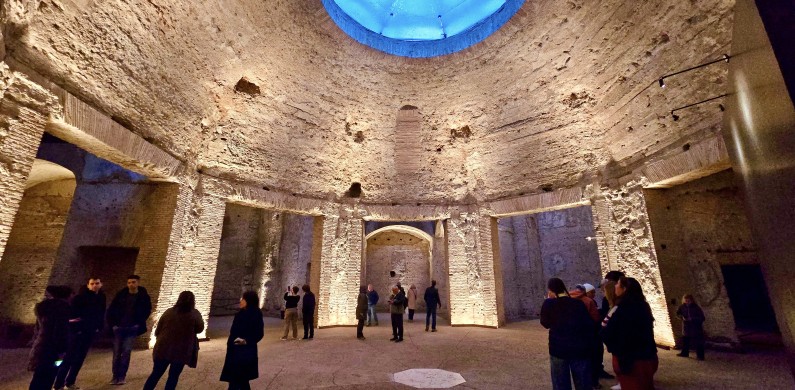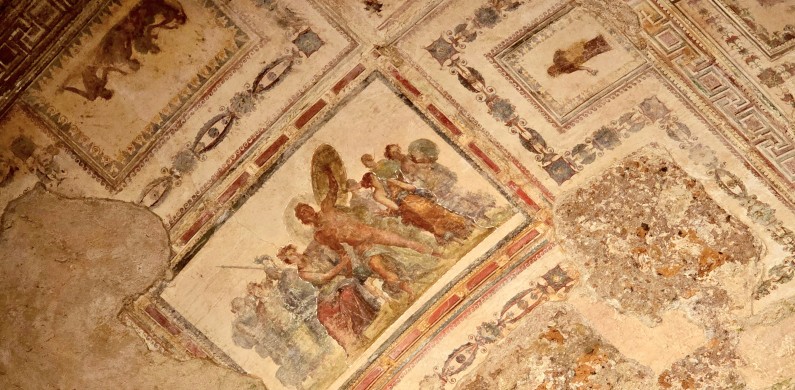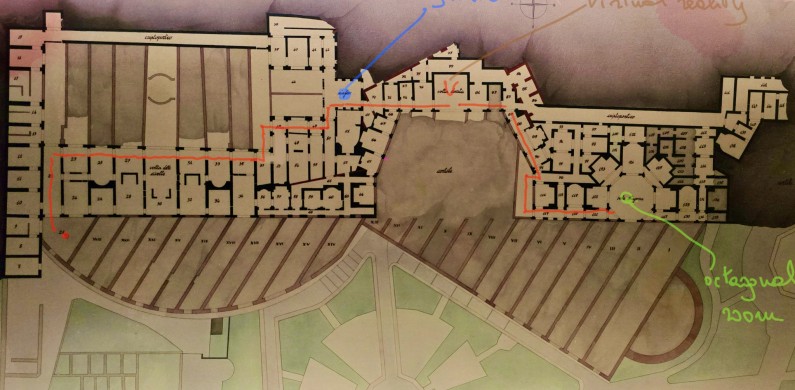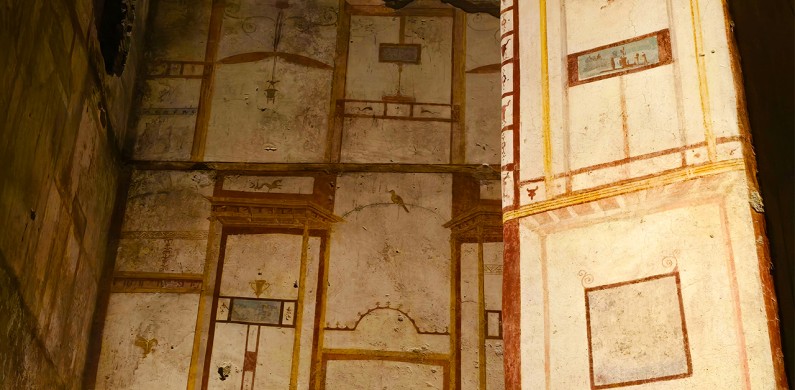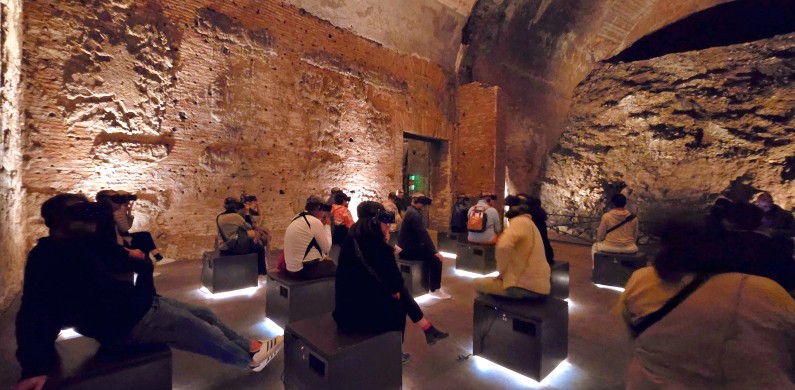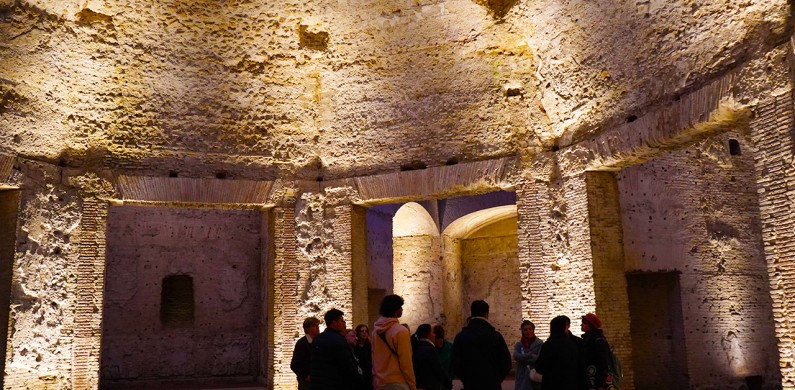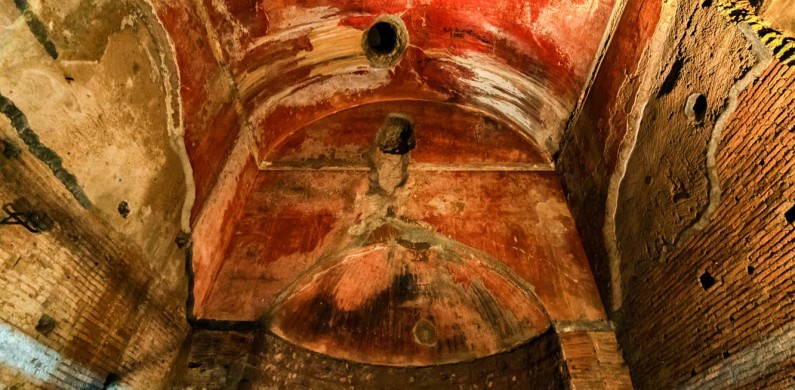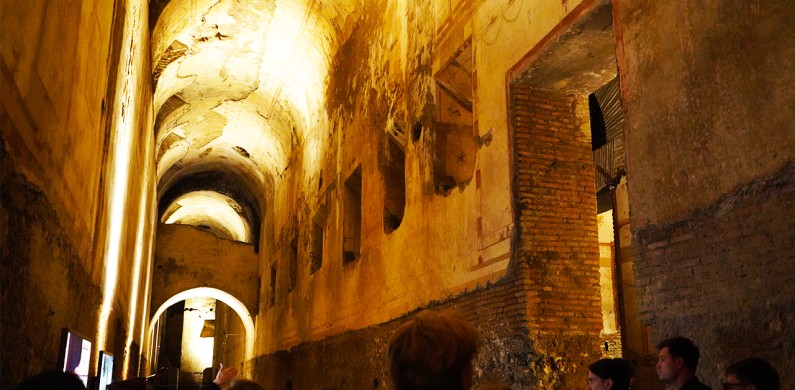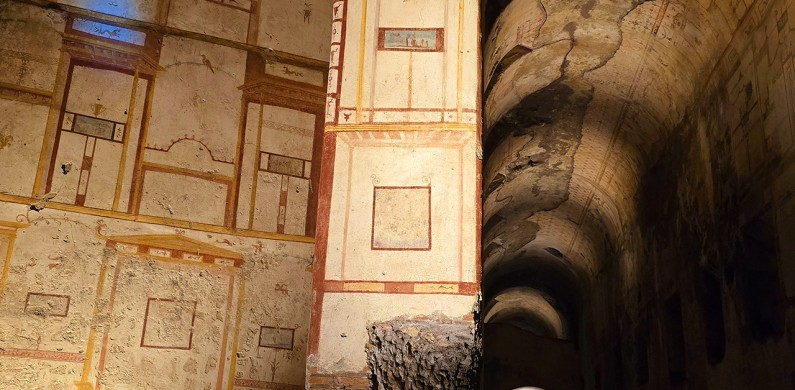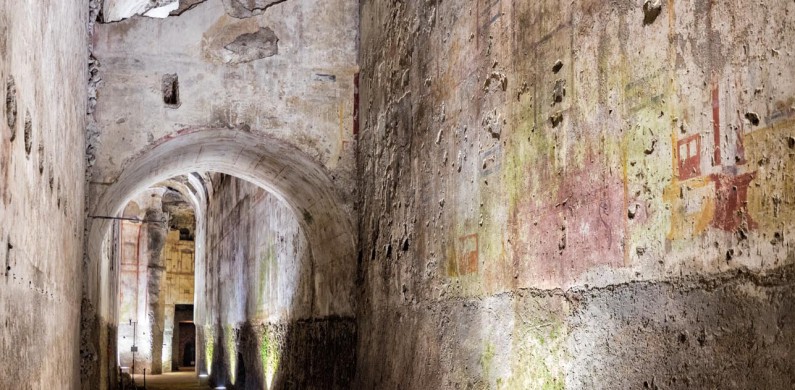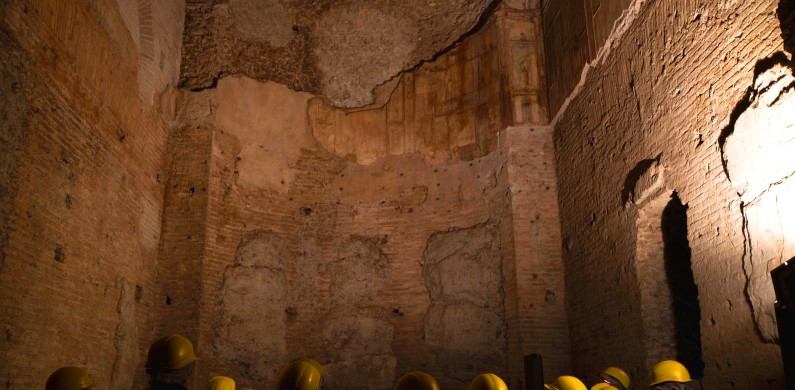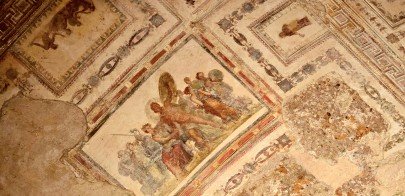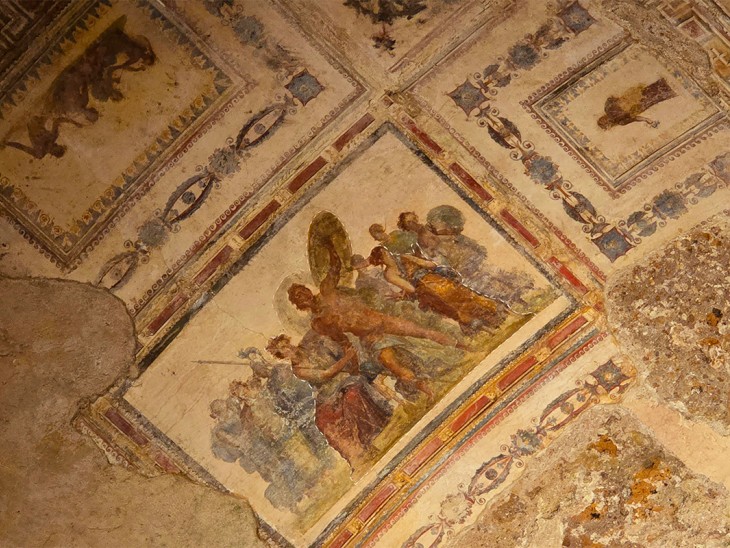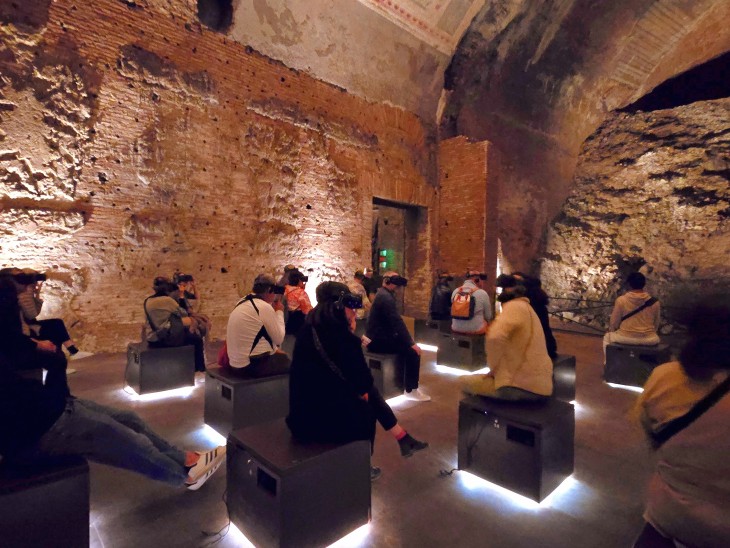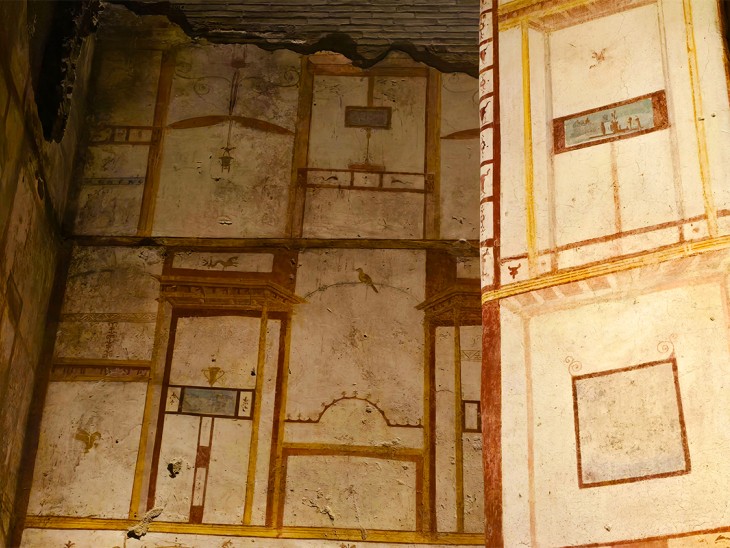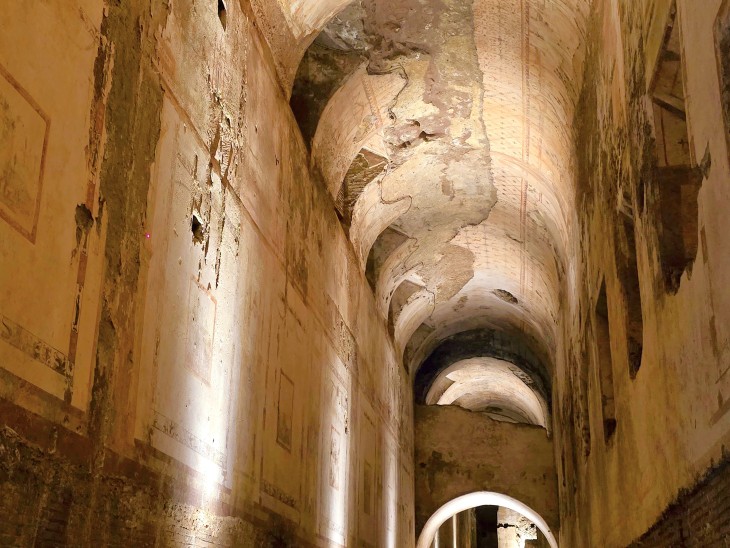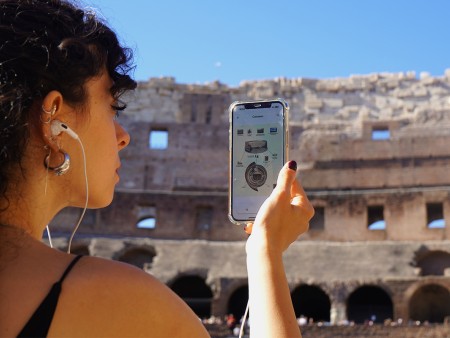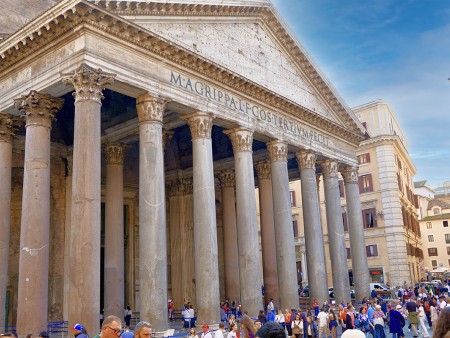Domus Aurea Tour: West and East Wing plus 3D virtual experience
Experience the halls and captivating frescoes of Nero's Golden House, uncovering the history and the splendor of Imperial Roman architecture, with Domus Aurea tickets included
Let yourself be carried away by our Domus Aurea tour, including entry tickets, into the most exclusive residence of Imperial Rome: Nero’s Golden Palace. Discover both the eastern and western wing, reopened in December 2024, of the vast architectural complex of the Domus Aurea. Walk through massive halls and barrel-vaulted corridors, many of them finely frescoed. Among them stands out the Octagonal Room, which is believed to have once featured a rotating ceiling.
Visit the Domus Aurea (Latin for “Golden House”),for a truly unforgettable journey into the private world of Emperor Nero. Step inside what was once one of the most lavish imperial residences in history: admire its stunning frescoes, discover the stories they tell, and explore the artistic style behind them. You’ll be amazed by the elegant layout of the palace: a series of luxurious rooms arranged around a vast central courtyard with grand porticoes.
It all began after the devastation of the great fire of July 64 AD, a common event in a city built largely of wood. It was not caused by Nero, who during those hot summer days was staying at his seaside residence, about 25 miles from Rome.
Guided by a passionate local archaeologist discover the stunning architectural complex of the Domus Aurea, originally spread over about 80 hectares, featuring an artificial lake at the center of luxurious buildings, scenic courtyards, porticoes and gardens. Relive the opulence of the original spaces flooded with light reflected off precious marble, enhanced by beautiful frescoes. Let yourself be guided by the archaeological evidence and the storytelling of our expert: today, the Domus Aurea lies in complete darkness, a vast underground palace, because Emperor Trajan, 40 years after Nero’s death, decided to erase his memory.
Feel part of history with our visit to the Domus Aurea, including an extraordinary 3D virtual experience. In a specially designed room, where fragments of the original frescoes still survive, you’ll wear the headset and step into a vivid reconstruction of Nero’s splendid palace.
With the most advanced technology, our Domus Aurea Tour makes the past shine in the present: the walls built by Emperor Trajan seem to dissolve, flooding the space with light from the pentagonal portico. The virtual journey continues into an ancient garden, where you glimpse the temples of the Capitoline Hill in the distance. For a few unforgettable moments, you’ll see what Nero once saw and feel his world awaken around you.
After all, as you will learn with our guide, the true protagonist of the Domus is none other than Emperor Nero himself, a sharp mind and an eccentric spirit. And our Domus Aurea guided tour takes you through the crucial moments of his life, placing them within the complex reality of Imperial Rome: a city teeming with over a million inhabitants, the heart of a vast empire.
By a strange twist of fate, Nero had very little time to enjoy his Golden House, as you’ll discover on our visit. He conceived it as a stunning art gallery to display his magnificent collection of classical works after the devastating Great Fire of 64 AD, which probably destroyed about two-thirds of Rome. But the emperor was forced to take his own life less than 4 years after the construction of his Golden Palace began, still unfinished. He was only 31 years old, and Rome had fallen into a severe economic and social crisis: covered in scaffolding, struggling through reconstruction, and deprived of adequate imperial funding. It was this that marked the collapse of Nero’s popularity, and his tragic end.
Nero’s Domus Aurea once shaped the heart of Rome and you can discover how the city evolved with our Forma Urbis Tour.
You can also explore the ruins of one of the most important Roman aqueducts on our Trevi Fountain and Piazza Navona Underground Tour.
NOTE: No discounts are available on Domus Aurea tickets for children, youth, or students. Domus Aurea tickets, included in the tour cost, are nominative, and entry is allowed only with IDs.
Group tour
18 max.
Duration
105 minutes
TOUR INCLUDES
2-Hour Exclusive Access to the West and East Wings of the Domus Aurea
Domus Aurea Tickets and Reservation Fees
Highly proficient English-speaking Archaeologist or Archeological Guide
Main sites Explored in the Tour
Yellow Vault Hall
Red Vault Hall
Owls' Vault Hall
Nymphaeum of Ulysses and Polyphemus
Room of Achilles on Skyros
The Octagonal Hall
Wonders discovered
The life of Emperor Nero, from his rise to the throne in 54 AD to the murder of his mother Agrippina in 59 AD, followed by the killing of his first wife Octavia in 62 AD - forced upon him by his mother - and his second wife Poppaea, who was likely pregnant. All the way to his suicide in 68 AD.
But above all, we will explore Nero's personal journey during the final four years of his life, from the Great Fire of Rome in 64 AD to his suicide in 68 AD. These were critical years for Roman history and architecture, highlighted by the construction of the Domus Aurea and the rebuilding of Rome with a new urban plan aimed at minimizing the impact of future fires.
This plan included measures such as a minimum distance between buildings, the widespread use of brick and stone instead of wood, and the widening of streets to facilitate emergency responses.
Dive Deep into Rome’s History with Our Domus Aurea Tour: The Timeless Story of Nero’s Golden Palace
A visit to the extraordinary, partially frescoed spaces of the Domus Aurea is an unmissable experience for history enthusiasts and lovers of Roman architecture and art. But it is also a fascinating journey through four pivotal years in Rome’s history. It begins with the Great Fire of 64 A.D., which left vast areas of the city in ruins and paved the way for Nero’s most ambitious project - the Domus Aurea, an enormous architectural complex, sprawling across the hills surrounding the Palatine Hill. But Nero's Golden Palace was short-lived. Following his suicide in 68 A.D., his successors sought to erase his legacy.
By the end of 69 A.D., Emperor Vespasian repurposed a small part of the immense complex, filling in the grand artificial lake to lay the foundations for what would become the Colosseum. Walking through the hauntingly beautiful ruins of Nero Golden Palace, you’ll step into a time of dramatic transformation - where power, destruction, and reinvention shaped the Eternal City.
With our archaeologist, you’ll also discover when and why the Domus Aurea was buried, how it was completely forgotten for centuries, and finally, uncovered 14 centuries after its construction, during the Renaissance. This rediscovery then inspired a famous artistic style known as the 'grotesque,' influencing generations of artists.
On our Domus Aurea tour, uncover the story of what is the Domus Aurea, what once was and what it has become today
The Domus Aurea was the most extravagant architectural project of Imperial Rome, a sprawling architectural complex designed to reflect the grandeur of an emperor who wanted to be regarded as more than just a mortal ruler."Covering an estimated 80 hectares, it extended across the Palatine, Esquiline, and Oppian Hills, featuring vast colonnaded courtyards, lush gardens, shimmering fountains, and even an artificial lake, where the Colosseum stands today. Nero’s vision was inspired by the majestic palaces of the Hellenistic monarchs, particularly the pharaohs of Egypt, who were venerated as divine beings. Their residences were conceived not as simple royal dwellings but as reflections of their godlike nature - vast, sacred spaces meant to inspire awe. With our guide - usually an archaeologist for this tour - you’ll discover that the Domus Aurea was not just the result of Nero’s obsession with power and grandeur. It was also a political strategy aimed at securing absolute power for the emperor as a divine figure.
Therefore the Domus Aurea was not just a residence but an artistic and architectural statement, adorned with gold, precious marbles, and elaborate frescoes that blurred the boundaries between human and divine.
Today, we call 'Domus Aurea' only the small portion of preserved spaces on the Oppian Hill, which now lie underground, located behind the Colosseum. On our Domus Aurea tour, you will realize that, although they represent only a small part of the original complex, these vast underground halls, with their towering vaults and refined decorations, offer us a glimpse into Nero’s taste and the artistic sensibilities of his time. They reveal the sense of space and light in the residences of Rome’s elite during the Imperial era. Through our guide’s storytelling, you’ll be transported into the world of thoughts and emotions they once lived in, making for an extraordinary experience.
Discover on our Guided Tour of the Domus Aurea the main features of its Architecture
The Latin expression Domus Aurea literally means Golden House. The name would come from the widespread use of gold as decoration in the palace, as described in the quote below, although it’s not the main interpretation.
“He built a palace that stretched from the Palatine Hill to the Esquiline Hill, and he called it the Domus Aurea. At the entrance hall stood a giant statue of himself, 120 feet tall. There was a three-part walkway, a mile long, and a lake that looked like a sea, surrounded by buildings made to resemble real cities, along with fields, vineyards, pastures, and woods full of animals, both wild and domesticated. Inside, everything was covered in gold and decorated with precious stones and mother-of-pearl. He had dining rooms with carved ivory ceilings, whose panels could turn and drop flowers, and they had pipes to spray guests with perfume. The dining rooms had ivory-carved ceilings with panels that could drop flowers on guests and pipes that sprayed perfume. The main dining hall was round and constantly turned, day and night, like the sky. There were also baths with seawater and thermal springs. When the palace was finished, Nero said, ‘At last, I can live like a real human being."
This passage comes from The Lives of the Caesars by Suetonius, specifically in his account of Emperor Nero. Suetonius was a Roman historian who wrote during the early 2nd century AD, about 40 years after Nero's suicide. His book The Lives of the Caesars is a collection of biographies covering the lives of the first twelve Roman emperors, from Julius Caesar to Domitian. His description of Nero’s Golden House emphasize the emperor’s extravagance and architectural ambitions after the Great Fire of Rome in 64 AD. But it's important to highlight that Suetonius didn't directly observe the Domus Aurea, he wrote about Nero’s Golden House about 40 years after its construction when it had been already abondoned and probably buried, likely based on reports from those who had seen it, from historical records or oral history, passed down from father to son with a lot of imagination. Morever he was an excellent writer, skilled at crafting impactful phrases rendering his texts memorable.
Discover on our Domus Aurea Tour with our archaeologist the most refined interpretation of the its name: the idea that it was an architecture of light. The beautifully frescoed interiors were almost always bathed in light, which bounced off the colorful frescoes and reflected on the fine marble, creating endless chromatic wonders. Especially in the grand, long porticos. So, in the end, the powerful structures of the Domus were designed to play with the delicate and immaterial beauty of light. Giving back the soft, pinkish light of dawn and the intense, golden glow of sunset, not just at the start and end of the day.
Our archaeologist will also introduce you to the two architects of the Domus Aurea on the tour, the two project and construction directors responsible for building this sort of city within Rome: Celere and Severus. They probably came from Egypt, the cradle of civilization, with grand cities like Alexandria and magnificent royal residences that inspired the design of the Domus. However, their names tell us a story: they are nicknames, possibly given by their workers or friends, capturing a trait of their personality, a quality or a flaw. “Celere” means quick, suggesting the architect was not only skilled but fast. “Severus,” on the other hand, means strict or rigorous, evoking an architectural style that’s both elegant and imposing. It could also refer to the architect’s character—stern, sober, and a man of few words.
Explore on Our Domus Aurea Tour its West Wing with an Archaeologist
The entrance to this wing of the Domus Aurea leads directly to the underground level. After descending a few steps, you’ll find yourself beneath the towering arches of the galleries built by Emperor Trajan about fifty years after Nero’s suicide. These galleries were constructed to support Trajan's massive bath complex, built right over the Domus Aurea. It may seem unthinkable to us, but at the time, it was almost a necessity: every trace of the infamous emperor had to be erased. You’ll learn why during the tour and through this summary.
The discovery of the west wing halls of the Domus Aurea, reopened to visitors in December 2024, offers an immediate sense of the vast scale and grandeur of the palace’s frescoed spaces. This section of the complex is laid out in a regular pattern around a large, three-sided portico - known as a peristyle, from the Greek word meaning “surrounded by columns” - with a central open courtyard. The fourth side of the portico never existed, as the palace, built on a hillside, did not extend beyond that point. However, to create a sense of architectural completeness, it was cleverly simulated with frescoes, some of which are still visible today. Though physically absent, the illusion demonstrates the remarkable artistic sophistication and spatial ingenuity of the Domus Aurea’s design.
Despite being entirely underground today, these vast spaces still preserve a sense of their original grandeur. With our expert guide, you’ll explore the Hall of the Red Vault, the Hall of the Owls’ Vault, and the Hall of the Yellow Vault - each named after the distinctive colors and motifs found in their frescoed ceilings. These large rooms have retained portions of their original paintings, often in remarkably vivid and evocative hues, carefully restored to their former brilliance.One of the most fascinating details our expert will reveal is a hidden mark left by a Renaissance artist from Raphael’s circle. In the late 1400s, unaware of what lay beneath, he descended through an opening in the vault and was so astonished by the stunning frescoes that he decided to leave his signature, a silent tribute to the forgotten masterpiece he had just rediscovered. With our guide, you’ll have the chance to spot this small yet extraordinary detail - an intimate glimpse into the wonder and fascination the Domus Aurea has inspired for centuries, from Nero’s Rome to the Renaissance and beyond.
Continue Exploring the East Wing with Our Domus Aurea Tour to the Octagonal Hall with our Archaeologist
The right wing of Nero’s Golden House was built over pre-existing structures, some of which had survived the Great Fire of 64 AD. This adaptation resulted in a less regular layout than the left wing, though the architectural design still maintained grandeur and symmetry. A visit to this part of the Domus Aurea reveals a succession of remarkable spaces that showcase Nero’s artistic ambition and the rich mythological world of Imperial Rome.
One of the most captivating rooms is the Nymphaeum of Polyphemus, a grotto-like chamber with A curved ceiling decorated with seashells, creating the effect of a natural cave. In the center of the ceiling, an unusual mosaic shows Odysseus blinding the one-eyed giant Polyphemus after getting him drunk—a dramatic moment from Homer’s Odyssey.
Nearby, the Hall of Achilles on Scyros dazzles with its intricate frescoes portraying the moment Achilles is discovered by Odysseus while disguised as a girl to avoid war, an episode rich with themes of fate and deception.The journey continues through a vast cryptoporticus, a long, semi-underground corridor that once connected different parts of the palace. Here, visitors can admire frescoes depicting deities and sacred Egyptian animals, reflecting Rome’s fascination with exotic cultures. These intricate decorations, blending Roman and Eastern artistic influences, add depth to the visual language of the Domus Aurea.
At the heart of this wing lies the extraordinary Octagonal Hall, a masterpiece of Roman engineering. Designed with an innovative dome, it played with light and shadow to enhance the illusion of movement, creating a dynamic and immersive space for banquets and entertainment. The vault, made of unreinforced concrete, has an opening at the top and is the predecessor of the majestic Pantheon, built about 50 years later by Emperor Hadrian. It is therefore one of the oldest surviving examples of vaulted ceilings, later recreated in many cathedrals from the Renaissance onward.
To its right, a vaulted chamber holds frescoes depicting the poignant farewell between Hector and Andromache, a moving testament to the human cost of war. Step into these forgotten spaces, where history, myth, and artistic mastery intertwine. Our expert archaeologist will bring Nero’s Golden House to life, offering a unique glimpse into the grandeur of Imperial Rome.
Experience Nero’s Golden Palace in all its original splendor: the Domus Aurea Tour in ancient time
Step beyond the limits of time and space as you enter a chamber adorned with ancient frescoes, their colors faded by centuries. Put on your VR headset, and suddenly, you are transported back to its original splendor. Gaze up at freshly painted frescoes glowing under streams of light from the grand windows. Below, the finest marbles, once applied to the walls, create mesmerizing patterns of color and depth. This one-of-a-kind experience is included in our exclusive Nero’s Golden Palace tour.
BOOK YOUR TOUR
From € 85 € 61
Likely to sell out
Last Reviews
[5.0]
The tour was very well organized and structured. First, our guide gave a historical context for Emperor Nero to better understand what he wanted to achieve with the building and why it was later filled in. Then the tour started inside. Because the groups were relatively small, you could see everything well and we particularly liked the virtual presentation at the end because you can see exactly how beautiful and magnificent it looked.
Our guide was absolutely perfect and the best guide we have ever had. He knew so many details and his speech was absolutely breathtaking from beginning till the end. The Domus Aurea Tour was our highlight.
Any visit to the recently-reopened Domus Aurea is worth your time, but if you are fortunate enough to get Rosario as your guide, you are twice-blessed. His commentary added so much to the basic tour. Our conversation outside of the group was equally enlightening and enjoyable.
You may also like ...
